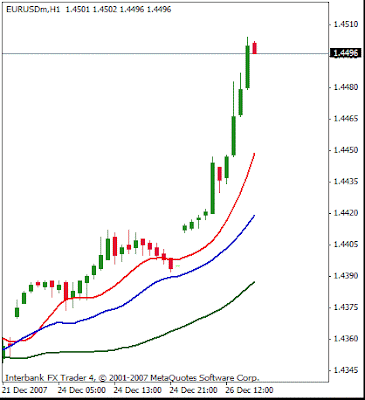Common Indicators
An Indicator is any tool that we use to help us predict future market trends.
Indicators can be categorised according to the type of prediction they make.
Leading indicators are oscillators that predict future trends and are designed to give traders the earliest possible warning of a trend change.
Lagging indicators are momentum indicators that follow events. They only signal new trends once they have occurred. Their importance though is to confirm the new trend is established or being established.
Coincident indicators occur at the same time as the trend change or trend continuation and are generally associated with fundamental announcements.
Much like support, resistance and trend lines, indicators not only provide entry and exit points for trades they also act as support and resistance areas.
In today’s electronic trading era there are literally thousands of indicators available. It would be impossible to look at all of them so we will concentrate on some of the more commonly used indicators.
Moving Averages
A moving average is a momentum indicator. It smooths out price over a fixed period of time. “Moving Average” means we are taking the average Closing, Opening, and High or Low price of a currency over a predetermined time period. As each time period ends it drops off the earliest data used and incorporates the latest data which is divided by the number of periods used to give us the average for the number of periods used.
IE a 14 period (Close) sma(simple moving average) on a 1hr chart adds the last 14 candles closing prices and divides them by 14 to give us an average price. When candle 15 opens then candle 1 is dropped off and the last 14 candles are counted giving us our moving average.
On the above chart 3 different sma's have been added 8, 21 and 55. The red 8, is the fastest and the green 55 is the slowest. The faster red would normally signal the direction change first then the blue 21 and last the green 55. The 2 slower sma's are also further from the current price than the faster sma.
We use moving averages to determine the direction of a trend and to smooth out small price fluctuations or "Noise" that might otherwise confuse our interpretation. The slope of the moving average, can alert us as to the general direction the future price will go.
There are different types of moving averages, and each of them has their own level of sensitivity or “smoothness”. Generally, the smoother the moving average, the less sensitive it is to change and the longer it takes to react to the price movement. The faster the moving average, the more sensitive it is to change and quicker it is to react to the price movement.
Moving averages can be shown as a single line on a chart or as a number of lines all with different values or settings. The combinations are limitless and the idea is to find a moving average or combination of moving averages that works well for you.
Simple Moving Average
If we look at the above 1 Hour GBPUSD chart using a 14 period SMA (simple moving average) We see the candles on the left of the chart are all below the 14 SMA. Around the mid point the sma line acts as resistance and price continues to drop. As long as the candles are opening and closing below the SMA we stay short in the market.
The above chart shows 2 crosses of the 14 sma line indicating 2 potential trading opportunities.
On the next chart we will add a 21 (red line) period SMA. Notice when the faster 14 (Blue) SMA crosses the slower 21 SMA we have a new trading opportunity to Sell GBPUSD when the first candle opens Below the faster Red 14 SMA. Notice also how the sma lines act as resistance most of the way down.
The same can be done with the High, Low or Open price of the last 14 candles. This is the simplest of moving averages. Again you need to play around with the combinations to find which one suits your trading style.
The longer the MA period the less sensitive it is to price change and the smoother the moving average line is, causing it to lag further behind the market. We therefore don't want too short a MA as it will give us too many false signals with every little change in the market. We also don't want too long a MA period as by the time it signals our entry the run could be over.
The MA gives us a broader view of the market not just the current view. This enables us to make a general determination of the future price for the time period we are trading.
Exponential Moving Averages
EMA's (exponential moving averages) place more weight on recent data and less weight on past data using the same number of candles or bars to calculate the moving average. By responding faster to change in price ema's are more reactive than sma's.
Sometimes sma's can signal false breaks because they are more prone to spikes in the market. Ema's can help to filter out these spikes because they place less emphasis on the older data. As traders we are interested in the more recent prices than the older prices.
On the above daily chart we have used 2 moving average lines, a 21 sma and a 21 ema. The red 21 ema responded first to the trend change . The entry on the red ema confirmed the long at 1.3550 it was already pointing in an upward direction, whilst the entry on the blue sma only confirmed the buy at 1.3666 when the first candle opened above the 21 sma and took a further 1o days to turn up.
The entry on the ema would have required a small stop compared large stop on the sma. The entry difference was 116 pips resulting in a huge difference in the profit potential between the 2 entries.
Whilst the difference may be negligible on a shorter time frame, trading the longer term trend makes a significant difference. As with all technical indicators none can guarantee success and are best used in conjunction with a support indicator.
There are advantages and disadvantages to using both sma's and ema's.
A short period EMA will respond quickly to price change which will help you catch trends early, resulting in larger profits. The disadvantage is you can get false signals. Because of the quick response the short period ema may interpret a spike or small retracement as a trend reversal causing you to enter the market in the wrong direction.
If we want to avoid the false signals then a longer period sma that is less sensitive to price change with smoother lines might be the best way to go. The downside is that it might take too long to recognise the trend change, causing you to miss good trading opportunities resulting in less profits.
There is a definite trade off between the two moving average types, earlier entries with more whipsaw or later entries with less profits and the possibility of entering the trade too late or missing the trade completely.
There are many trading systems designed around moving averages and only by back testing various periods, time frames and types of moving averages will you find a system that works well for you.
You might try ma cross overs or combining ema's and sma's. You can also try using combinations of high and low or opening and closing prices the permutations are endless.
Summary
- Moving averages help us identify trends across different time frames.
- Moving averages are momentum indicators that smooth out price and lag current movement.
- There are many types of moving averages, sma's and ema's are the 2 most common.
- Simple moving averages are prone to price spikes.
- Exponential ma's place more weight on recent prices showing us what traders are doing now.
- Simple moving averages are smoother than exponential moving averages.
- The longer the moving average period the slower it is to respond to change.
- The shorter the moving average period the quicker the response to change.
- The basis for moving avaerage trading is enter long when price crosses above the ma or short when it crosses below the ma.
- We should find a ma trade off that reduces whipsaw, but minimises the lateness of entries.
- Back test your ma's to find the appropriate combination.








No comments:
Post a Comment